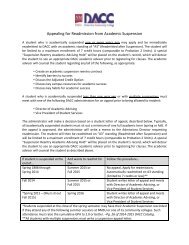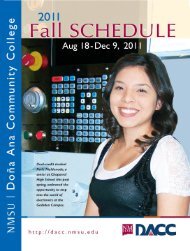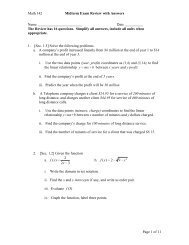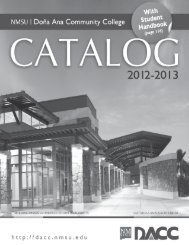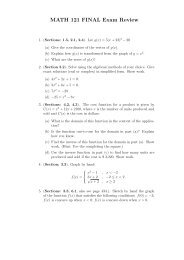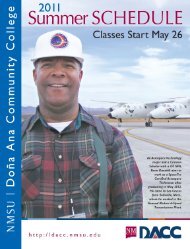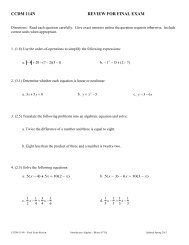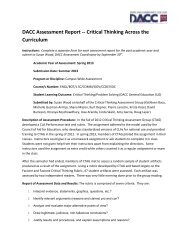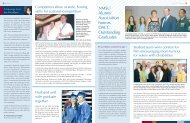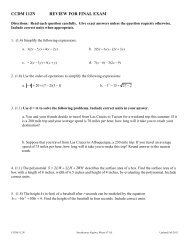online - Dona Ana Community College - New Mexico State University
online - Dona Ana Community College - New Mexico State University
online - Dona Ana Community College - New Mexico State University
Create successful ePaper yourself
Turn your PDF publications into a flip-book with our unique Google optimized e-Paper software.
• High school diploma or GED<br />
• Health Occupations Basic Entrance Test scores<br />
• GPA in college-level courses applicable to the respiratory care<br />
curriculum<br />
• Overall college GPA<br />
• Completion of prerequisites: OEHO 120 and either MATH 120<br />
or OEHO 116.<br />
A complete list is included in the application packet, available at the<br />
Respiratory Care program office in room 191 (phone: 527-7607).<br />
Requirements to Participate in Clinical Practice<br />
Clinical course work is required for completion of this program.<br />
Upon admittance and throughout the program, students will be required<br />
to meet requirements of each clinical site in order to complete<br />
the required course work. Requirements include but are not<br />
limited to the following:<br />
1 Background check through the designated college affiliate (adverse<br />
findings may disqualify a student from continuing in the<br />
program).<br />
2 Current CPR certification.<br />
3 Current TB test<br />
4 Record of immunizations for Measles, Mumps, Rubella, Chicken<br />
Pox, Hepatitis B.<br />
Associate Degree (74 credits)<br />
NOTE: Respiratory Care majors must receive a C or better in all<br />
Respiratory Care and related courses in order to remain in the program.<br />
Courses appearing in italics may be applied toward a bachelor’s<br />
degree at NMSU. In addition to the requirements listed here,<br />
certain Special Topics and Independent Study courses may be recommended<br />
by the adviser.<br />
OR<br />
OR<br />
OR<br />
OR<br />
OR<br />
OR<br />
General Education Requirements<br />
7 credits<br />
ENGL 111G, Rhetoric and Composition 4<br />
COMM 265G, Principles of Human Communication 3<br />
PSY 201G, Introduction to Psychology<br />
SOC 101G, Introductory Sociology<br />
OEBU 240, Human Relations<br />
OEHO 101, Communication for Health Care<br />
Related Requirements<br />
19 credits<br />
OEHO 153, Intro. to <strong>Ana</strong>tomy & Physiology I 4<br />
OEHO 154, Intro. to <strong>Ana</strong>tomy & Physiology II 4<br />
{<br />
BIOL 219 Public Health Microbiology (3) 4<br />
+ BIOL 221GL, Intro. Microbiology Laboratory (1)<br />
OEHO 253, Microbiology for Health Occupations<br />
and Laboratory (4)<br />
CHEM 110G, Principles and Applications of Chemistry 4<br />
C S 110G, Computer Literacy 3<br />
OECS 105, Intro. to Microcomputer Technology<br />
Technical Requirements<br />
45 credits<br />
OERC 110, Respiratory Care I 4<br />
OERC 110L, Respiratory Care I Lab 2<br />
OERC 112, Respiratory Care Physics 2<br />
OERC 120, Respiratory Care II 3<br />
OERC 120L, Respiratory Care II Lab 1<br />
OERC 123, Respiratory Care Pharmacology 2<br />
OERC 124, Respiratory Care II Clinical 5<br />
OERC 155, Respiratory Care Special Topics 0–4<br />
OERC 210, Respiratory Care III 2<br />
OERC 210L, Respiratory Care III Lab 2<br />
OERC 224, Respiratory Care IV Clinical 4<br />
OERC 230, Respiratory Care V 3<br />
OERC 230L, Respiratory Care V Lab 1<br />
OERC 233, Respiratory Care Cardiopulmonary 2<br />
Pathophysiology<br />
OERC 234, Respiratory Care V Clinical 3<br />
OERC 240, Respiratory Care VI 3<br />
OERC 240L, Respiratory Care VI Lab 1<br />
OERC 243, Resp. Care Neonatal Resuscitation 1<br />
OERC 244, Respiratory Care VI Clinical 4<br />
Water Technology<br />
EPA <strong>State</strong> Environmental Training Program<br />
Associate Degree: Water Utility Operation<br />
Certificate of Completion<br />
527-7584<br />
The Water Technology program is an award-winning, up-to-date<br />
technical training opportunity that will open doors to a career anywhere<br />
in the United <strong>State</strong>s. Graduates from this two-year program<br />
have found work in <strong>New</strong> <strong>Mexico</strong>, Colorado, Texas, Arizona, California,<br />
Vermont, <strong>New</strong> Hampshire, and Puerto Rico. More than 300<br />
graduates have begun careers in the water field, working in such<br />
diverse areas as the semiconductor industry, the food processing<br />
industry, aerospace industry, electrical power industry, city water<br />
and wastewater departments, municipal or contract analytical laboratories,<br />
water reuse or recycling plants, metal plating companies,<br />
engineering consulting firms, and state planning offices.<br />
While jobs are widely available, training programs like this one are<br />
rare. As the treatment of water becomes more technical, municipalities<br />
and industries rely on training programs to fill their needs.<br />
Students in this program learn how to clean water to make it safe for<br />
drinking and how to purify water to a high quality for use in computer<br />
chip manufacturing, food processing, or steam generation. They<br />
will also learn how to treat wastewater so it can be safely returned to<br />
the environment or reclaimed for beneficial use. Instruction also includes<br />
maintaining equipment such as pumps, motors, valves, and<br />
chemical feeders; laboratory testing and analysis; water chemistry<br />
and microbiology; and some basics of supervising and managing a<br />
water utility, including budgets, preventive maintenance schemes,<br />
and billing. Various course assignments requiring laboratory data<br />
sheets, simple process control spreadsheets, and term papers enable<br />
students to sharpen their computer and writing skills. General studies<br />
in basic algebra, applied math, water chemistry and microbiology,<br />
speech, and technical writing round out the curriculum.<br />
Opportunities for students to gain new knowledge and skills in operations,<br />
maintenance, and laboratory areas are provided through<br />
2 0 0 7 - 2 0 0 8 C A TA L O G<br />
61



